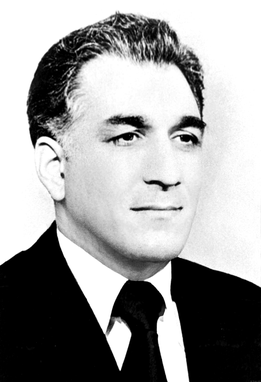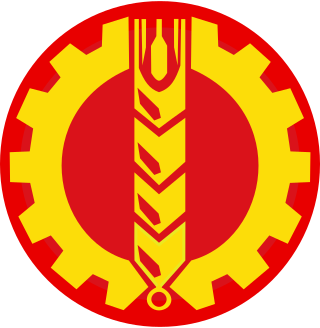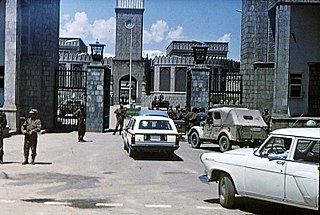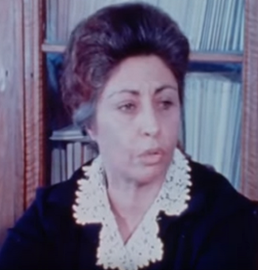
Babrak Karmal was an Afghan communist revolutionary and politician who was the leader of Afghanistan, serving in the post of general secretary of the People's Democratic Party of Afghanistan from 1979 to 1986.

Hafizullah Amin was an Afghan communist head of state, who served from September 1979 until his assassination. He organized the Saur Revolution of 1978 and co-founded the Democratic Republic of Afghanistan (DRA), ruling Afghanistan as General Secretary of the People's Democratic Party.

Mohammad Najibullah Ahmadzai, commonly known as Dr. Najib, was an Afghan politician who served as the General Secretary of the People's Democratic Party of Afghanistan, the leader of the one-party ruling Republic of Afghanistan from 1986 to 1992 and as well as the President of Afghanistan from 1987 until his resignation in April 1992, shortly after which the mujahideen took over Kabul. After a failed attempt to flee to India, Najibullah remained in Kabul. He lived in the United Nations headquarters until his assassination during the Taliban's capture of Kabul.

The Democratic Republic of Afghanistan (DRA), renamed the Republic of Afghanistan in 1987, was the Afghan state during the one-party rule of the People's Democratic Party of Afghanistan (PDPA) from 1978 to 1992. It relied heavily on assistance from the Soviet Union for most of its existence, especially during the Soviet–Afghan War.

The People's Democratic Party of Afghanistan (PDPA) was a Marxist–Leninist political party in Afghanistan established on 1 January 1965. Four members of the party won seats in the 1965 Afghan parliamentary election, reduced to two seats in 1969, albeit both before parties were fully legal. For most of its existence, the party was split between the hardline Khalq and moderate Parcham factions, each of which claimed to represent the "true" PDPA.
The following lists events that happened during 1986 in Afghanistan.
The following lists events that happened during 1981 in Afghanistan.

Nur Muhammad Taraki was an Afghan revolutionary communist politician, journalist and writer. He was a founding member of the People's Democratic Party of Afghanistan (PDPA) who served as its General Secretary from 1965 to 1979 and Chairman of the Revolutionary Council from 1978 to 1979.

Parcham was the more moderate socialist faction of the People's Democratic Party of Afghanistan (PDPA) led by Babrak Karmal. It was later turned into the Watan (Homeland) Party with a more Islamic outlook under Mohammed Najibullah. The faction was formed directly after the founding of the Party in 1965 following ideological splits in the PDPA. While the Parchamites' stressed the need for swift social-economic reforms to achieve revolution, this was in direct contrast with their PDPA rivals, the Khalqists, who sought an immediate and violent overthrow of the government. Karmal believed that Afghanistan was not developed enough for a Leninist revolutionary approach and instead sought a patriotic and anti-imperialist united front to take the next steps toward revolution.

Khalq was a faction of the People's Democratic Party of Afghanistan (PDPA). Its historical de facto leaders were Nur Muhammad Taraki (1967–1979), Hafizullah Amin (1979) and Sayed Mohammad Gulabzoy (1979–1990). It was also the name of the leftist newspaper produced by the same movement. The Khalq wing was formed in 1967 after the split of the party due to bitter resentment with the rival Parcham faction which had a differing revolutionary strategy.

Sulaiman Layeq was an Afghan communist politician, ideologue and poet who held the positions of President of the Academy of Sciences, full member of the Afghan Politburo, and Minister of Nationalities and Tribal Affairs.

The Saur Revolution or Sowr Revolution, also known as the April Revolution or the April Coup, was staged on 27–28 April 1978 by the People's Democratic Party of Afghanistan (PDPA) and overthrew Afghan president Mohammed Daoud Khan, who had himself taken power in the 1973 Afghan coup d'état and established an autocratic one-party system in the country. Daoud and most of his family were executed at the Arg in the capital city of Kabul by PDPA-affiliated military officers, after which his supporters were also purged and killed. The successful PDPA uprising resulted in the creation of a socialist Afghan government that was closely aligned with the Soviet Union, with Nur Muhammad Taraki serving as the PDPA's General Secretary of the Revolutionary Council. Saur or Sowr is the Dari-language name for the second month of the Solar Hijri calendar, during which the events took place.
The following lists events that happened during 1980 in Afghanistan.
The following lists events that happened during 1982 in Afghanistan.

The Democratic Republic of Afghanistan was the government of Afghanistan between 1978 and 1992. It was recognised diplomatically by only eight countries which were allies of the Soviet Union. It was ideologically close to and economically and militarily dependent on the Soviet Union, and was a major belligerent of the Afghan Civil War.

Mir Akbar Khyber was an Afghan left-wing intellectual and a leader of the Parcham faction of People's Democratic Party of Afghanistan (PDPA). His assassination by an unidentified person or people led to the overthrow of Mohammed Daoud Khan's republic, and to the advent of a socialist regime in Afghanistan, the Democratic Republic of Afghanistan.

The Revolutionary Council of the People's Democratic Party of Afghanistan (PDPA) ruled the Democratic Republic of Afghanistan from 1978 until its collapse in 1992. The council was the supreme state power under the communist regime and was a carbon copy of the Supreme Soviet in the Soviet Union. The point with the council was to convene on a semiannual basis to approve decisions made by the presidium.

Anahita Ratebzad was an Afghan socialist and Marxist-Leninist politician and a member of the People's Democratic Party of Afghanistan (PDPA) and the Revolutionary Council under the leadership of Babrak Karmal. One of the first women elected to the Afghan parliament, Ratebzad was deputy head of state from 1980 to 1986.
The 3 Hoot uprising refers to a week of major civil unrest in Kabul, Afghanistan that started on 22 February 1980, occurring two months after the Soviet intervention. It is named after the date and month it started in the Solar Hijri calendar. Protests, rioting and a popular uprising against the Babrak Karmal-led Democratic Republic of Afghanistan government was triggered, by one account due to a series of mass arrests by the regime. Alternatively it has been said that the murder of Lieutenant Alexander Vovk, an instructor of the Soviet Komsomol, by an unknown gunman in the city, which led to the killing of civilians by a group of Soviet officers, led to the uprising.
Assadullah Amin was an Afghan politician and the nephew of Hafizullah Amin. He was the head of the Afghan intelligence agency KAM from September 1979 until December 1979, when his uncle was assassinated by the KGB. Assadullah Amin was executed by the Soviet backed Afghan Government of Babrak Karmal for his role in KAM a year later.












